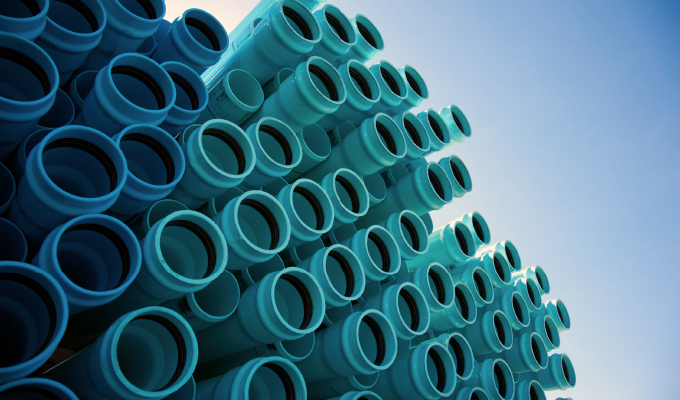By Mark Ligon
Many applications, including drainage and irrigation, require piping to be installed underground. Both PVC and CPVC can be laid underground, combined with fittings attached using solvent cement. However, it’s important to follow best practices in storing and handling piping prior to installation. In addition, contractors should adhere to state and local building codes and ASTM guidelines to ensure the integrity of the installation. Use this guide to learn more about the proper underground installation of PVC and CPVC pipe.
MAINTAIN INTEGRITY
Both PVC and CPVC pipes are quite durable. However, in order to maintain the integrity of your pipes underground, you must first take proper care in storing and handling them. Avoid storing PVC and CPVC piping in direct sunlight, which could cause discoloration and weakened tensile strength over time. Instead, keep it in a shaded area, where it can’t become damaged from high temperatures or crushed with weight of other items. Take care in transporting piping to jobsites as well. Dragging or dumping the pipes could increase the chances of cracking, breaking, or split ends once they have been buried.
Prior to installing the piping underground, be sure to inspect it. Look for any signs of damage, including gouges, cuts, or split ends that could impact the strength and effectiveness of the pipe once installed. If found, cut damaged sections from the pipe and discard them.
PROPER GUIDELINES
When installing PVC or CPVC piping underground, it’s important to follow American Society for Testing and Materials, or ASTM, Standards. These standards ensure that contractors follow proper guidelines for pipe installation, including trench construction and pipe depth. These standards vary based on the pressure and contents of the piping, as well as areas in which the piping will be installed. Failing to follow ASTM guidelines could cause pipes to fail, leading to the potential for flooding and water damage in the future.
Create trenches that are wide enough for installation and allow for expansion and contractions with changes in temperature, but do not dig trenches wider than necessary. Remove large rocks from the trench, as well, or cover them with tamped earth prior to installation, so that pipes won’t be damaged underground. Avoid joining pipes inside the trench. Instead, join them above ground and wait for fittings to cure completely before placing the line in the trench.
Pipe depth is also an extremely important consideration for underground installations. All PVC or CPVC piping should be laid at least 12 inches below the frost line to limit the possibility of ruptures in freezing temperatures. In areas of heavy traffic, pipe depth should be between 24 to 36 inches, and where constant heavy traffic is expected, piping run with metal or concrete casting may be required. Refer to ASTM Standards and stage and local codes to determine the correct pipe depth for your installation.
Backfill only when the solvent cement on all joints has fully cured, and the outside temperature is within 15 degrees of the average working temperature. Ensure that the entire line of piping is properly supported and stable prior to filling the trench as well. The initial backfill material should not include rocks or gravel larger than .5 inch. Tamp with either vibration or water flooding before adding final backfill layers, which can include particles up to 3 inches.
UNDERGROUND APPLICATIONS
Many contractors prefer to use CPVC piping in underground applications, such as water supply lines and drainage lines, because it offers several benefits:
- Cost effective. CPVC is low cost and does not require thrust blocks, additions to the line that prevent pipes from moving or shifting and causing damage, as metal and PVC pipes do.
- Resistant to corrosion. CPVC is made to resist damage from corrosive substances, such as soil pH and underground salts. This ensures a longer service life with fewer repair costs.
- Abrasion resistant. CPVC is preferred for underground installation because there’s a lower chance of debris damaging the material and causing leaks and failure.
CLOSING THOUGHT
Because of their strength and durability, both PVC and CPVC piping are excellent options for underground applications. Prior to installation, inspect piping to ensure that it is free from damage. Then, dig trenches in accordance with state and local codes, as well as ASTM guidelines. Join piping above ground, and let joints fully cure before placing them in the trenches, providing supports and metal or concrete castings as needed. Then backfill using material free from large rocks and gravel. These steps will ensure the integrity of the underground piping for the future.
About the author:
Mark Ligon is the marketing manager of Commercial Industrial Supply, a leading supplier of commercial PVC and CPVC pipe, fittings, and valves. Mark enjoys educating businesses on the parts of piping systems so managers can make informed decisions. He can be reached at webmaster@commercial-industrial-supply.com. For more, visit
www.commercial-industrial-supply.com.
Modern Contractor Solutions, March 2021
Did you enjoy this article?
Subscribe to the FREE Digital Edition of Modern Contractor Solutions magazine.



